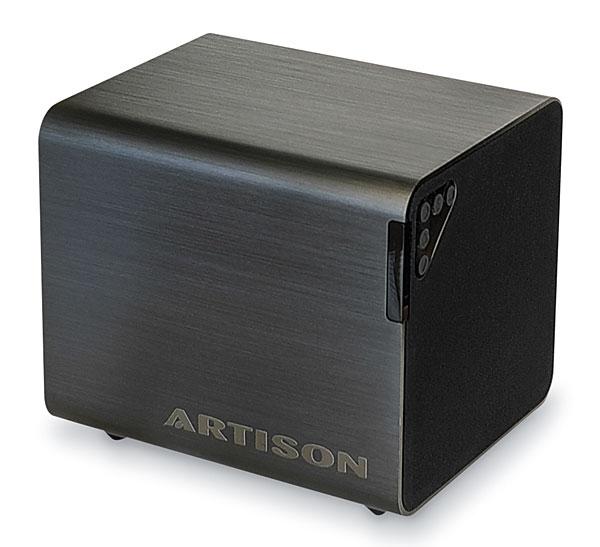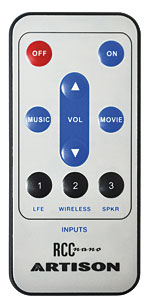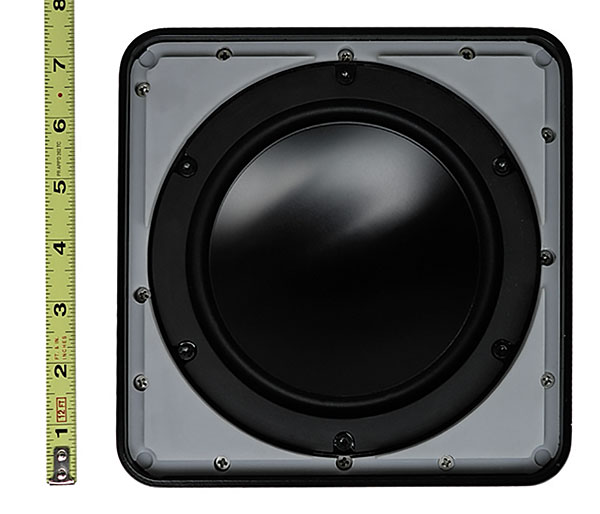Could someone please get their hands on and review the Devialet Phantom wireless subwoofer and the Expert Audiophile Evolutive System. This wireless speaker is said to fill a room and have no distortion even at the highest levels. It's said to be better than Sonos. The amp wirelessly connects to many speaker brands.
Artison RCC Nano 1 Subwoofer Review

AT A GLANCE
Plus
True bass from truly tiny sub
Highly flexible setup, including wireless option
Beautifully made and
finished
Minus
Finite upper-volume limits
Display too small to discern easily
THE VERDICT
If you demand real bass from a really small subwoofer (and you have $1,000 to pay for it), Artison’s got your micro-sub.
Ever since the first hominid bashed another hominid over the head (with the femur of a third hominid), humankind has pursued one arms race or another. From the atlatl to the AR-15, man’s competitive genius always finds a way to up the ante. One rather more constructive expression of this innate drive can be seen in the long-standing contest to extract more and more bass out of smaller and smaller boxes.
Witness the RCC Nano 1. At just 7.5 x 8 x 9 inches and a flyweight 18 pounds, the new micro-subwoofer from Artison, a Nevada maker best known for elegant on-wall speakers, packs some fairly high tech to squeeze a claimed 32 hertz from a sub having the approximate footprint of a healthy honeydew. An extruded-aluminum enclosure yields maximal internal volume for minimum external space, while DSP and a Class D amp backed up by a switch-mode power supply and output claims of 300 watts (900 W peak) provide the magic required to conjure up loud ’n’ low from opposed-paired 6.5-inch aluminum-cone drivers; the opposing force of the moving masses in this configuration limits cabinet vibrations (and keeps the little sub from “walk- ing” across hard surfaces at full cry).
“Jewel-like” is an expression perhaps overused in audio reviews, but the Nano earns the sobriquet. You can see it in the sub’s beautifully black-anodized, slim-wall aluminum cabinet, with shadow-etched “Artison” and pinpoint-blue-LED columnar display along one corner, as well as in its Bentley-like fit of grille seams and control edges (and classy packaging).
Setup
Setting up the Artison proved a bit tricky. First, the five push buttons that serve as the user interface, arranged in one corner, aren’t immediately intuitive in their operation. Second, the connectors and setup controls are all teeny-tiny, recessed into a shallow bay inset on the sub’s bottom panel. (Admittedly, this makes for a sanitary setup in the end.) Third, the eight-segment LED column, the sub’s only readout, is discreet to the point of near-invisibility in a well-lit room. (And at floor level, it’s pretty much impossible to determine the number of lit segments for volume, even in a dim room.) Nonetheless, a bit of study in the manual—which, frankly, could be more explicit and better labeled—and a couple of tries brought the little sub to life. Despite its miniaturization, the Artison offers a full array of subwoofer features: both line- and high-level inputs
(on 1/8-inch and IEC/Phoenix bare-wire terminals, respectively), plus wireless operation (via the company’s deck-of-cards-sized, $149-option transmitter); continuous crossover and phase knobs, and audio-sense/
12-volt-trigger/manual power-mode toggles.
A second minijack accepts a wired IR sensor for in-cabinet deployments,
a second wire terminal connects the aforementioned trigger.

I initially set up the Nano right next to my everyday sub, a towering SVS PC12-Plus, where it looked like something the latter might have given birth to. I connected the transmitter to my pre/pro’s subwoofer output via a supplied (and very classy) short minijack/RCA adapter cable. The proprietary transmitter box is billed as one-touch simple, and indeed, sub and transmitter paired in response to a single three-second button press—yay! Since I expect most users will be mating the Nano with slim or small on-wall or in-wall speakers, I began with a standard 80-Hz crossover to my main-front stand-mount monitors.
The audible result was promising. The Nano made a fairly easy match to my left/right pair, producing fully satisfying bass weight and depth from pop music and jazz. Like any subwoofer, it proved highly sensitive to placement, and as with most bass-limited smaller subs, I found myself adjusting its level a bit from audio program to program. I axed a slight residual heftiness by switching the sub’s crossover-slope mini- toggle from 12 to 24 decibels per octave; despite having the crossover frequency knob all the way up, which allowed my pre/pro’s crossover to do the work, this seemed to render a slight but valuable tightening. I subsequently concluded that moving the Nano smack into a front corner (instead of my long-proven big-sub location several feet out) gleaned a decibel or two of useful level and, perhaps, a few hertz of additional low-end extension.
 Performance
Performance
After my setup adjustments, a song like Tower of Power’s classic “Down to the Nightclub” (from 1972’s Bump City) sounded very nearly as punchy as with my everyday behemoth, as long as the master volume remained reasonable: loud, but not excessively so. At the threshold of practical conversation, the little Artison lost a good deal of punch on bassist Rocco Prestia’s trademark pops, and the puff of the B3 organ’s low notes lost body and impact. But within
its volume abilities, the tiny sub reproduced a low D from a five-string (or drop-tuned four-string) electric bass—about 37 Hz—with a measure of fundamental authority, as well as enough “bass mass” to balance overall musicality nicely, which is damned impressive for something smaller than a breadbox.
Movie sound was fairly remarkable, too. A cable showing of Mission: Impossible II produced the requisite deep impacts at healthy (if not fully cinematic) levels. Of course, the tiny Artison couldn’t match my everyday sub for floor-bending sub-bass on the movie’s largest-scale explosions, but it easily yielded fully involving sound (without tripping my ear/brain mechanism’s inadequate-bass warnings)—orders of magnitude better than those of the similar-sized “subwoofers” included with most HTIB systems.

All this held true for any rational levels in my roughly 2,800-cubic- foot office/studio: music playback I’d describe as “near-party,” but still short of “nuisance-complaint.” Pushing volume beyond this point induced no pain or shutdown from the Nano; it simply stopped “keeping up.” The result was that overall tonality became brighter, or at least less balanced, as the Artison’s very smart limiting protected it from self-destruction or even from producing any rude noises. This was particularly evident on most pop music, which is highly compressed. A full orchestra, which rarely exploits higher bass levels, could sound remarkably good and quite dynamic even at near-concert-hall levels. I preferred the Artison’s “Music” EQ preset to its “Movie” one for all listening. This clearly went lower and sounded tighter, with considerably less boom, at the sacrifice of perhaps 4 or 5 dB of max level. Multiple Nanos might be a viable option for bigger spaces: The manual states that up to three can be driven from a single wireless link, and while there’s no wired daisy-chain output, a Y-cable or two could accomplish the same end.
I did note a couple of ergonomic issues. First, the Nano’s audio-sensing auto on/off was poorly calibrated. The sub takes a solid 30 seconds to come to life (apparently, there’s an elaborate DSP-boot routine), yet my sample had only a five-minute or so delay for no-signal turn-off. So if you have a long, quiet sequence followed by a sudden explosion (for example), you’re going to miss out on the bottom end of that boom. (Artison told us at press time that the no-signal turn-off is now set to about 15 minutes, though the best solution might be to either leave the sub always on or drive it with a 12V trigger from the receiver or preamp.)

Second, I encountered an odd ground-loop problem with the Artison wireless link when powering the transmitter from a convenient USB port. Whether it was powered from a port on my pre/pro, Blu-ray deck, or cable box, an odd, burbling whine was audible about 30 dB down—more than loud enough to be clearly heard over quiet scenes or passages, and painfully evident on silent ones. But when I powered the transmitter box from its supplied USB-out wall-wart, this disappeared entirely; lesson learned. (Artison’s manual doesn’t explicitly state that the transmitter can be powered by a USB port, but neither does it forbid it. The sub was perfectly silent when hard-wire connected.)
Bottom Line
The fact that you can buy louder/deeper bass for half the Nano’s price but 27 times its volumetric size is obvious. Artison’s new micro
is without doubt the smallest serious
sub, with serious performance, I’ve ever encountered, the first 6-inch (OK, 6.5-inch) subwoofer I’ve found to be truly worthy of the name. I dropped it into my “civilian” home theater (TV room), whose everyday sub is a home-brew sealed-12, and over the course of a week of casual TV and movie viewing, I found little to complain of. This smaller room, where calls for reference level are rare, seems the perfect sort of place for the Nano.
Me, I’m not quite ready to sacrifice that last half-octave (and a hatful of decibels) for a few cubic feet of lebensraum, but I know my other half would do it in a New York minute—a factor likely to key the Nano’s success. But bass-heads and their loved ones may not need to compromise much longer; if the trend suggested by Artison’s RCC Nano 1 is any guide, in another few decades we’ll be enjoying 15 Hz at 120 dB from a sugar cube.
- Log in or register to post comments































































